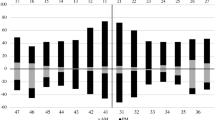Abstract
We measured the quantity of D-aspartic acid (degree of racemization of aspartic acid) in the enamel of different types of teeth from the same individual. We studied the correlation between the degree of racemization and the time of formation of each particular tooth, as well as the applicability of the degree of racemization to estimation of chronological age. If the environmental condition of the teeth is the same, the degree of racemization is expected to be highest in teeth that completed formation in the earliest period of time. Different degrees of racemization in enamel were found among different types of teeth, even in the same individual. The degree of racemization in enamel was found to be higher in molars than in incisors, and showed a tendency that did not necessarily coincide with the time of formation. This seemed to be due to the fact that the environmental temperature was higher in the molar region located deeper in the oral cavity than the front region, and that enamel was more affected by breathing air than dentin because the D/L ratios in enamel were lower than those in dentin. Using enamel, a better estimation of chronological age was obtained from calculations based on the degree of racemization of each type of tooth than from all the different teeth together. However, these estimated ages were not better than those from dentin.
Similar content being viewed by others
References
Bada JL, Kvenvolden KA, Peterson E (1973) Racemization of amino acids in bones. Nature 245:308–310
Helfman PM, Bada JL (1975) Aspartic acid racemisation in tooth enamel from living humans. Proc Natl Acad Sci U S A 72:2891–2894
Helfman PM, Bada JL (1976) Aspartic acid racemisation in dentine as a measure of ageing. Nature 262:279–281
Ohtani S, Yamamoto K (1991) Age estimation using the racemization of amino acid in human dentin. J Forensic Sci 36:792–800
Ritz S, Stock R, Schütz HW, Kaatsch HJ (1995) Age estimation in biopsy specimens of dentin. Int J Legal Med 108:135–139
Carolan VA, Gardner ML, Lucy D, Pollard AM (1997) Some considerations regarding the use of amino acid racemization in human dentine as an indicator of age at death. J Forensic Sci 42:10–16
Ritz S, Turzynski A, Schütz HW (1994) Estimation of age at death based on aspartic acid racemization in noncollagenous bone proteins. Forensic Sci Int 69:149–159
Pfeiffer H, Mörnstad H, Teivens A (1995) Estimation of chronologic age using the aspartic acid racemization method. 1. On human rib cartilage. Int J Legal Med 108:19–23
Pfeiffer H, Mörnstad H, Teivens A (1995) Estimation of chronologic age using the aspartic acid racemization method. 2. On human rib cortical bone. Int J Legal Med 108:24–26
Ritz S, Turzynski A, Schütz HW, Hollmann A, Rochholz G (1996) Identification of osteocalcin as a permanent aging constituent of the bone matrix: basis for an accurate age at death determination. Forensic Sci Int 77:13–26
Ohtani S, Matsushima Y, Kobayashi Y, Kishi K (1998) Evaluation of aspartic acid racemization ratios in the human femur for age estimation. J Forensic Sci 43:949–953
Ohtani S (2002) Technical notes for age estimation using the femur: influence of various analytical conditions on D-aspartic acid contents. Int J Legal Med 116:361–364
Masters PM, Bada JL, Zigler JS Jr (1977) Aspartic acid racemisation in the human lens during ageing and in cataract formation. Nature 268:71–73
Fujii N, Ishibashi Y, Satoh K, Fujino M, Harada K (1994) Simultaneous racemization and isomerization at specific aspartic acid residues in αB-crystallin from the aged human lens. Biochem Biophys Acta 1204:157–163
Man EH, Sandhouse ME, Burg J, Fisher GH (1983) Accumulation of D-aspartic acid with age in the human brain. Science 220:1407–1408
Mesotten K, Gunst K, Carbonez A, Willems G (2003) Chronological age determination based on the root development of a single third molar: a retrospective study based on 2513 OPGs. J Forensic Odontostomatol 21:31–35
Willems G (2001) A review of the most commonly used dental age estimation techniques. J Forensic Odontostomatol 19:9-17
Ohtani S (1995) Estimation of age from the teeth of unidentified corpses using the amino acid racemization method with reference to actual cases. Am J Forensic Med Pathol 16:238–242
Olze A, Schmeling A, Taniguchi M, Maeda H, Niekerk P van, Wernecke KD, Geserick G (2004) Forensic age estimation in living subjects: the ethnic factor in wisdom tooth mineralization. Int J Legal Med 118:170–173
Schmeling A, Schulz R, Reisinger W, Mühler M, Wernecke K-D, Geserick G (2004) Studies on the time frame for ossification of the medial clavicular epiphyseal cartilage in conventional radiography. Int J Legal Med 118:5–8
Ohtani S, Yamamoto K (1992) Estimation of age from a tooth by means of racemization of an amino acid, especially aspartic acid—Comparison of enamel and dentin. J Forensic Sci 37:1061–1067
Ohtani S, Sugimoto H, Sugeno H, Yamamoto S, Yamamoto K (1995) Racemization of aspartic acid in human cementum with age. Arch Oral Biol 40:91–95
Hare PE, Abelson OH (1968) Racemization of amino acid in fossil shells. Carnegie Inst Wash Yearb 66:526–528
Ohtani S, Ito R, Yamamoto T (2003) Differences in the D/L aspartic acid ratios in dentin among different types of teeth from the same individual and estimated age. Int J Legal Med 117:149–152
Abe I, Kuramoto S, Musha S (1983) Chiral phases derived from XE-60 for glass capillary gas chromatography of amino acid enantiomers. J Chromatogr 258:35–42
Bada JL, Schroeder A (1975) Amino acid racemization reactions and their geochemical implications. Naturwissenschaften 62:71–79
Logan WHG, Kronfeld R (1983) Development of the human jaws and surrounding structures from birth to the age of fifteen years. J Am Dent Assoc 20:379–427
Spierings TA, Peters MC, Plasschaert AJ (1984) Surface temperature of oral tissues. A review. J Biol Buccale 12:91–99
Moore RJ, Watts JT, Hood JA, Burritt DJ (1999) Intra-oral temperature variation over 24 hours. Eur J Orthod 21:249–261
Collins MJ, Waite ER, Van Duin ACT (1999) Predicting protein decomposition: the case of aspartic acid racemization kinetics. Philos Trans R Soc Lond B 354:51–64
Ritz-Timme S, Collins MJ (2002) Racemization of aspartic acid in human proteins. Ageing Res Rev 1:43–59
Author information
Authors and Affiliations
Corresponding author
Rights and permissions
About this article
Cite this article
Ohtani, S., Ito, R., Arany, S. et al. Racemization in enamel among different types of teeth from the same individual. Int J Legal Med 119, 66–69 (2005). https://doi.org/10.1007/s00414-004-0506-8
Received:
Accepted:
Published:
Issue Date:
DOI: https://doi.org/10.1007/s00414-004-0506-8




